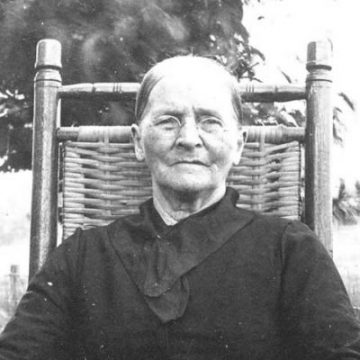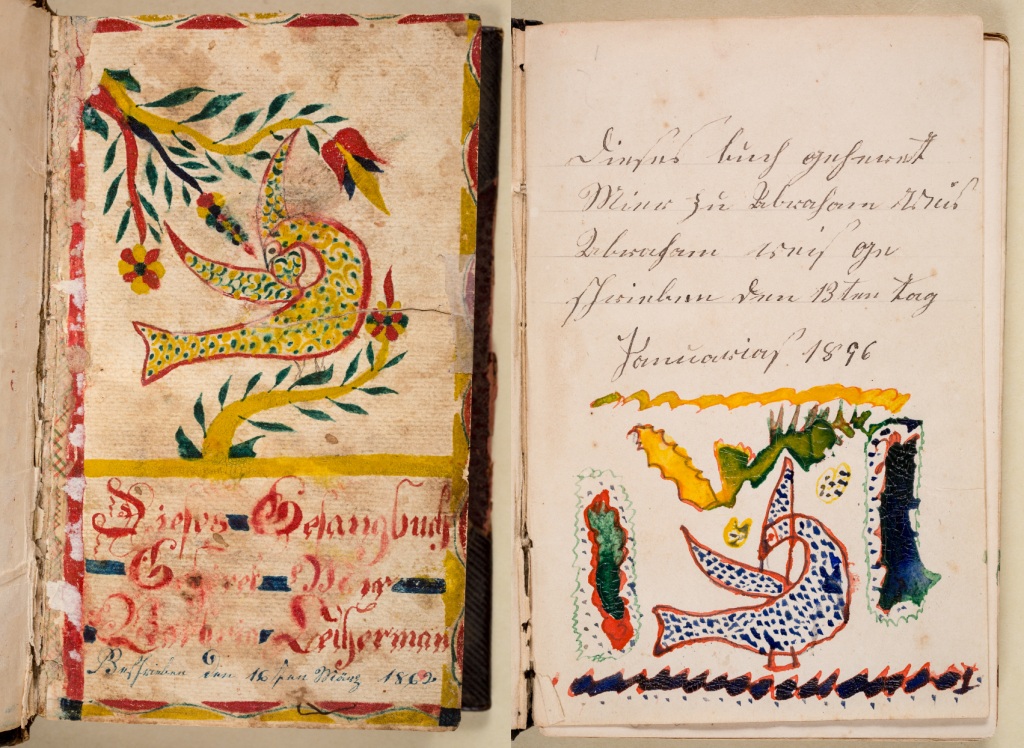Our Immigrant Heritage: Detweiler
Written by Forrest Moyer on May 24, 2017

This series of posts highlights families descended from 18th-century Mennonite immigrants to eastern Pennsylvania, in connection with the MHC’s exhibit Opportunity & Conscience: Mennonite Immigration to Pennsylvania, on display through March 31, 2018. The stories reflect the enrichment brought to communities over centuries by the descendants of immigrants.
An old world devotional
John [Johannes] Detweiler (1721-1806) was born when his immigrant parents, Hans and Susanna, were in the first years of trying to carve out a life in the Skippack woods. They had arrived in 1717, as part of the first large group of Mennonites to come to Pennsylvania.
John grew and married Anna Reiff, also the child of immigrants. They are buried in the Lower Skippack Mennonite Cemetery, where their fieldstone grave markers have been embedded in a handsome granite marker by descendants.

The gravestone of John’s sister Anna (1712-1767), who came with her parents from Germany, is on display in the Opportunity & Conscience exhibit (borrowed from Salford Mennonite Cemetery), along with her fascinating story. The stone reads “AN [Anna] x AD [Alderfer] 1767”. Click the photo to enlarge and read the story.
In the Isaac Clarence Kulp Collection at the MHC is a devotional book thought to have been owned by John Detweiler, son of the immigrant. It is inscribed with his name (or his son Johannes), as well as two of his daughters, Hanna and Magdalena, and Magdalena’s son-in-law Joseph Markley.
Though the title page is missing, the book appears to be Martin Moller’s Manuale de praeparatione ad mortem: Heilsame und sehr nützliche Betrachtung, wie ein Mensch Christlich leben und seliglich sterben sol, possibly the 1747 edition printed by Wöllern at Franckfurt am Mayn, Germany. Detweiler probably purchased this book from a later immigrant in the 1760s.
The first section in the book is on “The Proper Art of Dying”, illustrating how important preparation for death was to people in those days. Sections follow on “The Christian Life”, “The Seven Rules of the Cross,” “What to do in Case of Illness,” etc.
Contained in the book was this colorful folk art drawing of a bird, probably from the mid-19th century.

Peter Detweiler, late fraktur artist
At Deep Run, a son of the Detweiler family — Peter L. Detweiler (1844-1896) — was one of the last fraktur artists of the 19th century, along with his peer Isaac Kulp, whose work was shown earlier on this blog. Though schoolhouses had moved to English instruction by the time of Detweiler and Kulp’s childhood, someone continued teaching German fraktur in Bedminster Township through the mid-19th century (perhaps Jacob Gross?).
In 1896, old schoolteacher and Deep Run minister Samuel Godshalk wrote to fellow preacher Jacob Mensch that “we have a German School in the old Schoolhouse, which I visit occasionally for pas time [sic].” Peter Detweiler, Godshalk’s son-in-law, and/or Isaac Kulp may have taught this German school.
Work attributed to Detweiler is crude compared to fraktur of the early 19th century. In this bookplate on lined paper, signed “PD 1896”, lines are simple and coloring was done with crayon. His knowledge of German seems somewhat limited as he spelled gehört incorrectly and wrote the month Mertz [March] as Merch. The script handwriting at the bottom of the page appears practiced rather than natural.

Mennonite Heritage Center Collection; gift of Catherine M. Frederick (2013. 29.1).
The bookplate below left is stylistically related and may be an example of earlier work by Peter Detweiler. It was made in 1862 for Barbara Leatherman, who was either Peter’s grandmother or aunt. The piece came to the MHC from a relative.
A bookplate written in 1896 for Abraham Rice at Deep Run carries the same unique bird image, probably drawn by the 14-year-old Rice. Could this have been an image that Detweiler used repeatedly in fraktur and passed on to Rice in the 1890s German school at Deep Run?

Barbara Leatherman bookplate gift of Blanche Detweiler High (1990.1.2); Abraham Rice bookplate found in collection (2015.21.1).
Domestic art by Detweiler women
The MHC collection contains several pieces of domestic art by women of the Detweiler family, including this embroidered sampler made by Fannie Detweiler of Franconia Township in 1854 when she was 14 years old. The sampler includes alphabets in three styles and a variety of motifs, including potted plants, birds, a heart, a crown, and even a little dog. Fannie later married Joseph Hendricks of Hilltown Township, and they were members of the Blooming Glen Mennonite congregation. The sampler was given to the MHC by Fannie’s great-grandson Wilbur Hendricks (2007.37.1).


This crazy quilt top from the Detweiler family was pieced circa 1923-25, but never quilted or backed until just before it was donated to the MHC in 2004. It is a friendship quilt, bearing the names of several Detweiler women — Mrs. Mahlon D. Detweiler (Malinda Alderfer) of West Rockhill Township, her teenage daughter Ella (who would pass away at age 18 in 1925), daughters-in-law Sallie and Hannah, and Malinda’s sister-in-law Mary Allebach Alderfer of Souderton. All of these women attended Rockhill Mennonite Church, where the Detweiler family was prominent in the 20th century.

Gift of Margaret Kulp Koch (2004.21.1).
Another beautiful and unique quilt from the Rockhill Detweiler family is this “orange-peel” quilt purchased at the household auction of Samuel Detweiler near Souderton in 1976. It may have been made by his wife Katie Benner Detweiler (1905-1968). The difference is striking between the symmetry and balanced color of this pattern quilt and the “crazy” whimsy of Malinda Detweiler’s scrap quilt, but both illustrate the artistry and skill of women who married into the Detweiler family.

Mennonite Heritage Center purchase (1976.86.1).
Twentieth century Mennonite leaders
The Detweiler family produced several important leaders for the Mennonite community in the 20th century. One was Richard C. Detweiler (1924-1991), ordained by lot at age 24 to serve as the first resident minister of Perkasie Mennonite Church, and at 30 ordained to serve as a bishop in Franconia Mennonite Conference. The same year he was asked to become principal of the new Christopher Dock Mennonite High School near Lansdale.
After twelve years at Perkasie Church and Dock School, Richard pastored Souderton Mennonite Church until 1980, when he was called to serve as President of Eastern Mennonite College in Harrisonburg, VA. Returning to Pennsylvania in 1988, he served as an administrative overseer for Franconia Conference and led the conference’s pastoral training program until his untimely death in 1991. His brother, Robert C. Detweiler (1932-2008), was also an accomplished scholar and professor who served for a time as President of the American Academy of Religion.

Richard Detweiler speaking at the Christopher Dock Mennonite High School graduation in 1961, in front of the administration building later named for him.

Fraktur by Bishop John Lapp commemorating Detweiler’s inauguration as President of Eastern Mennonite College in 1981. Mennonite Heritage Center Collection (1992.21.1).
Another set of Detweiler brothers who made a significant contribution to Mennonite religious and spiritual life in the 20th century were Bill and Bob Detweiler, twin sons of William & Anna Landes Detweiler. The Detweiler’s had moved from Blooming Glen, first to Norristown, PA and then to Canton, OH to work in Mennonite missions. There they began a radio evangelism ministry — the “Calvary Hour” — which was heard on 20 stations at the time of William’s death from a heart attack in 1956. His sons, in their mid-twenties at the time, took up the ministry, and the Calvary Hour was heard throughout the United States and a few foreign countries until 2007.

Bill and Bob Detweiler. Source: gameo.org
Sources on the Detweiler family
Correll, Ernst H. and John C. Wenger. “Detweiler (Dettweiler, Dittwyler, Dettwiler) family.” Global Anabaptist Mennonite Encyclopedia Online. 1956. Web. 7 Mar 2017. http://gameo.org/index.php?title=Detweiler_(Dettweiler,_Dittwyler,_Dettwiler)_family&stableid=119530
Smith, Elizabeth A. Zern. A Genealogical History of the Detweiler, Detwiler Family: The Descendants of Johannes and Anna (Reiff) Detweiler. Bountiful, UT: Family History Publishers. 1993.
Steiner, Sam. “Detweiler, William Gehman (1903-1956).” Global Anabaptist Mennonite Encyclopedia Online. December 2009. Web. 7 Mar 2017. http://gameo.org/index.php?title=Detweiler,_William_Gehman_(1903-1956)&stableid=113320
The Calvary Hour 50th Anniversary: 1936-1986: A Half Century Using Radio for the Glory of God. Orville, OH: Calvary Hour. 1986.
Waite, Frances W. and Thomas G. Webb. Hans Detweiler Family History. Self-published. 1993.
On Richard C. Detweiler:
Hershey, Mary Jane Lederach. “Richard C. Detweiler: in his own words.” MHEP Quarterly 14, no. 1 (Spring 2011): 3-10. Online at http://www.mhep.org/files/PDF/newsletters/2011spring.pdf
Steiner, Sam. “Detweiler, Richard Clemmer (1924-1991).” Global Anabaptist Mennonite Encyclopedia Online. September 2016. Web. 7 Mar 2017. http://gameo.org/index.php?title=Detweiler,_Richard_Clemmer_(1924-1991)&stableid=136010
“Richard C. Detweiler: Sixth President, 1980-87.” Eastern Mennonite University. Web. 16 September 2016. https://www.emu.edu/president/emeriti/richard-c-detweiler/

